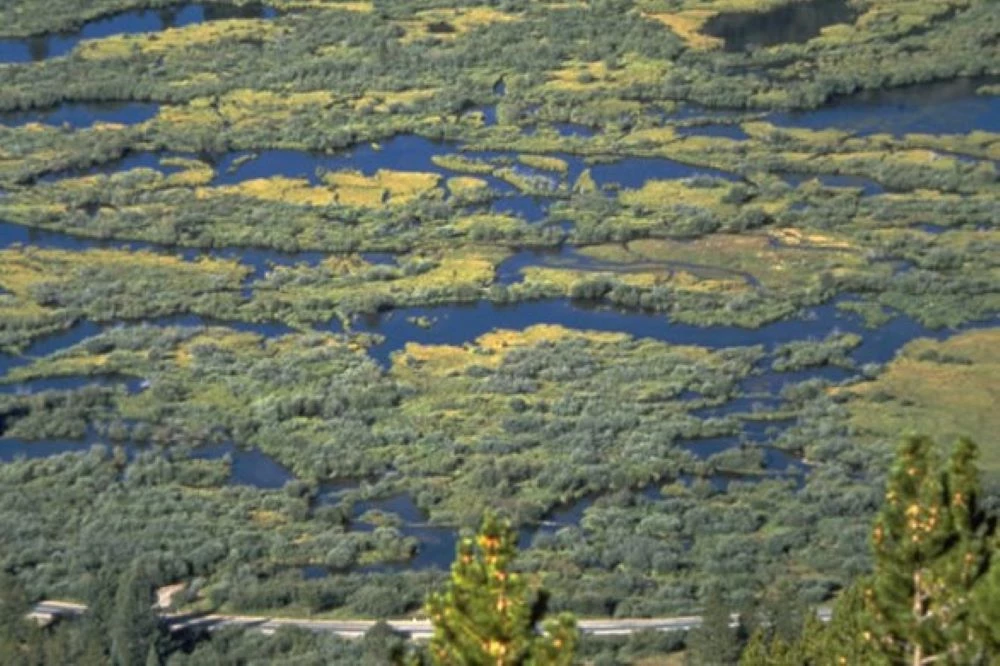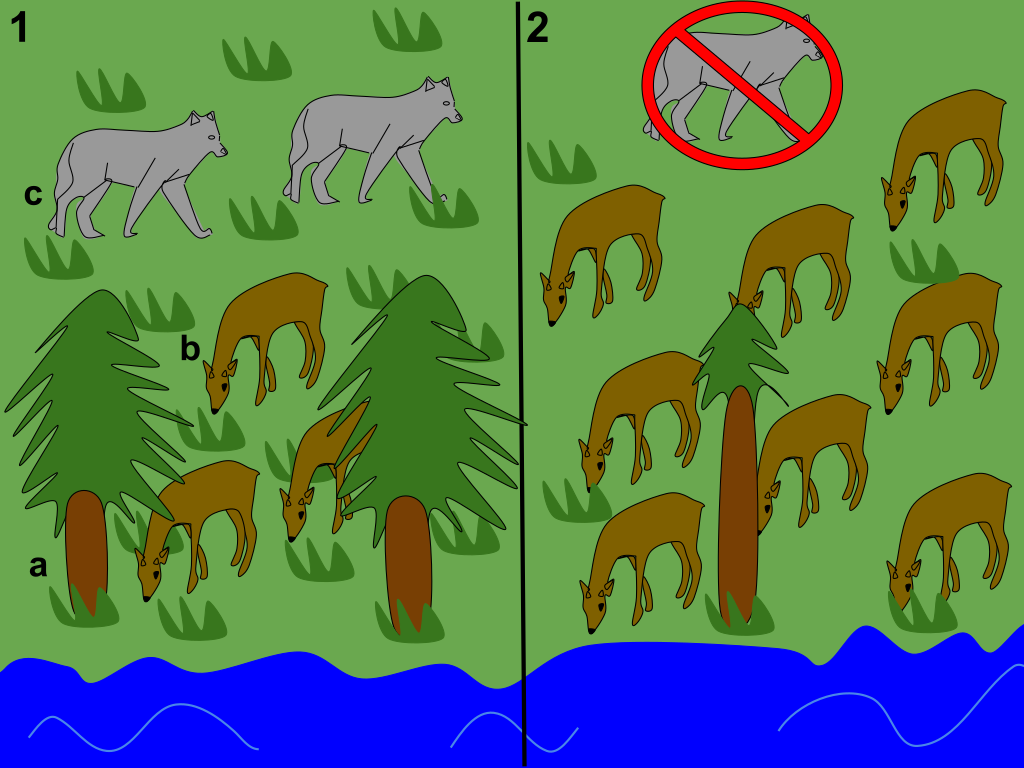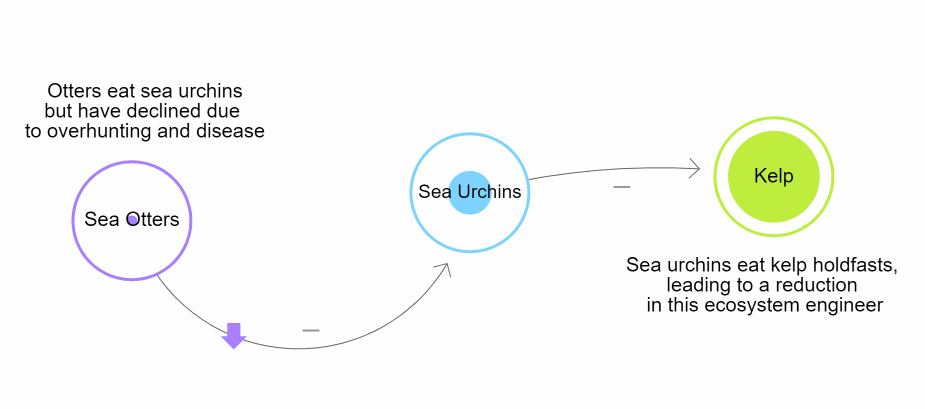Keystone species are instrumental in shaping the structure and function of their ecosystems. Their activities and interactions significantly influence biodiversity and ecological processes, making their conservation a priority for maintaining ecological balance and diversity.
Role of Keystone Species
Keystone species exert a disproportionate influence on their ecosystems. Their presence, activities, and interactions shape the composition, structure, and processes of the environments they inhabit.
Maintaining Biodiversity
Influence on Other Species: Keystone species directly and indirectly affect the populations and behaviours of other organisms. Their predation, competition, and other interactions regulate species abundance and distribution, preventing dominance by particular species and promoting biodiversity. Understanding the population distribution of these species can highlight their critical roles in various ecosystems.
Habitat Creation and Modification: Keystone species like beavers are renowned for their ability to transform landscapes. Beavers build dams, creating ponds and wetlands that provide habitats for a plethora of species, enhancing biodiversity. These transformations tie closely with their niche and habitat which define their roles and interactions within their ecosystems.

Beaver damming enlarges and connects wetlands, slowing water flow, trapping sediment, and creating diverse aquatic and riparian habitats for plants, invertebrates, fish, amphibians, and birds. This image shows a beaver-influenced wetland within Rocky Mountain National Park. Source.
Resource Availability: The activities of keystone species can influence the availability of resources within an ecosystem. They can affect the distribution and abundance of resources, impacting the survival and reproduction of other species.
Trophic Cascades
Predator-Prey Dynamics: Keystone predators, such as wolves, play a crucial role in controlling the population of prey species. Their predation checks overpopulation of species like deer, preventing overgrazing and promoting plant diversity. The dynamics of these interactions are central to understanding trophic interactions within the ecosystem.

Diagram of a top-down trophic cascade: wolves (apex predators) regulate deer (primary consumers), which in turn protects trees and other primary producers from over-browsing. The two-panel layout contrasts systems with and without wolves to emphasise indirect effects on plants. Source.
Influence on Lower Trophic Levels: The presence of keystone predators affects the behaviour and population density of prey species. This influence trickles down to plant and decomposer species, affecting their abundance and diversity.
Importance in Ecosystems
Keystone species are cornerstones for the stability, resilience, and diversity of ecosystems. Their removal or decline can lead to drastic changes, often resulting in reduced biodiversity and ecosystem degradation.
Ecosystem Stability
Balance: Keystone species contribute to the equilibrium of ecosystems. They check the population of dominant species, preventing them from monopolising resources and habitats, thus fostering a balanced, diverse community.
Resilience: Ecosystems with robust keystone species are often resilient. They can withstand, adapt, and recover from disturbances and changes, including natural disasters, climate change, and human interventions. These species play a critical role in maintaining the community structure of their ecosystems.
Biodiversity Enhancement
Species Richness: Keystone species create conditions that support a variety of organisms. Their activities and interactions lead to an increase in the number of species within an ecosystem.
Ecological Niches: By influencing the physical environment and interspecies interactions, keystone species facilitate the existence of diverse ecological niches. These niches support a wide array of organisms, enhancing biodiversity.
Examples of Keystone Species
Examining specific examples of keystone species provides insights into their varied roles and the profound impacts they have on ecosystems.
Sea Otters
Prey Regulation: Sea otters predate on sea urchins, keeping their population in check. Without sea otters, sea urchins can devastate kelp forests, leading to a loss of habitat and biodiversity.

Schematic of the sea-otter–urchin–kelp cascade: otter predation reduces urchins, decreasing grazing pressure and allowing kelp to recover, with knock-on effects for biodiversity and habitat structure. The figure abstracts interactions into nodes and arrows to emphasise direction and sign of effects. Source.
Ecosystem Impact: Healthy kelp forests, maintained by sea otters, are biodiverse ecosystems. They support a rich variety of species, including fish, invertebrates, and other marine organisms, and provide essential services like carbon sequestration.
Elephants
Habitat Modification: Elephants are landscape architects. Their feeding and foraging behaviours, such as uprooting trees and trampling vegetation, transform forests into grasslands, creating habitats for grassland-adapted species.
Biodiversity Promotion: Elephants facilitate plant diversity. They disperse seeds through their dung, contributing to the propagation and diversity of plant species. This plant diversity, in turn, supports a varied animal community.
Challenges and Conservation
The conservation of keystone species is paramount due to their significant impacts on ecosystems. However, they face threats that endanger their populations and the ecosystems dependent on them.
Threats
Human Activities: Urban development, deforestation, pollution, and climate change pose significant threats. Habitat loss and degradation, driven by these factors, undermine the survival of keystone species.
Poaching and Hunting: Targeted for their body parts, skins, or trophies, some keystone species face the threat of poaching and hunting. This illegal activity leads to population decline and can disrupt ecosystem balance.
Conservation Strategies
Legal Protections: Enacting and enforcing laws to protect keystone species from hunting, poaching, and habitat destruction is crucial. International, national, and local regulations can offer these species the legal safeguards they need. Effective conservation strategies are essential for sustaining populations and their ecological functions.
Habitat Restoration: Initiatives to restore and preserve the natural habitats of keystone species are essential. These efforts ensure that these species have the ecological conditions necessary for their survival, reproduction, and population growth.
Public Awareness: Educating the public about the importance of keystone species and the threats they face can galvanise support for their conservation. Awareness campaigns, educational programmes, and media engagement can foster a culture of conservation.
In the intricate web of life, keystone species are the linchpins that hold ecosystems together. Their conservation is not merely about protecting individual species but is integral to preserving the rich biodiversity and ecological processes that characterise our planet. Every measure taken to safeguard these species is a stride towards a balanced, resilient, and sustainable natural world, where biodiversity thrives, and ecosystems flourish in harmony.
FAQ
Yes, the role of a keystone species can change over time due to environmental or anthropogenic factors. Environmental changes such as climate change, natural disasters, or changes in the populations of other species can alter the influence of a keystone species. Anthropogenic activities like deforestation, pollution, and urban development can also impact their role. For instance, pollution might weaken a keystone species, reducing its ability to influence its ecosystem effectively. Adaptations to these changes can lead to a shift in the role and impact of keystone species, affecting ecosystem dynamics and biodiversity.
The removal of a keystone species can initiate a trophic cascade, a domino effect impacting species across various trophic levels. For instance, if a keystone predator is removed, its prey’s population can increase exponentially, leading to overgrazing or overconsumption of primary producers. This overexploitation can reduce plant biodiversity and impact the populations of other herbivores and their predators. The effects can cascade down to decomposers and up to apex predators, leading to a significant shift in ecosystem structure, function, and biodiversity, and sometimes resulting in ecosystem collapse if the balance is not restored.
No, keystone species are not always predators. While many well-known examples, such as wolves or sea otters, are predators that influence their ecosystems through top-down regulation of prey populations, keystone species can also be plants, herbivores, or ecosystem engineers. For example, certain plant species can be keystone species because they provide critical resources or habitats for other species. Ecosystem engineers like beavers transform landscapes, creating new habitats and ecological niches that support diverse communities. Thus, the term "keystone species" refers to the role and impact a species has on its ecosystem, not its trophic level.
Conservation efforts for keystone species are often tailored to address the specific threats and challenges these species face, considering their pivotal role in ecosystems. These efforts may include habitat preservation and restoration, legal protections against hunting and poaching, and targeted interventions to bolster their populations. For instance, if a keystone species is threatened by habitat loss, conservationists might focus on protecting and restoring its habitat. Public awareness campaigns can also be crucial to garner public support for conservation initiatives, highlighting the species’ role in maintaining ecosystem health, stability, and biodiversity.
Keystone species can significantly influence the behaviour of other species within their ecosystems through mechanisms like predation, competition, and habitat modification. For example, the presence of a keystone predator can lead to a phenomenon known as the "landscape of fear," where prey species alter their foraging habits and habitats to avoid predation. This change in behaviour can lead to a redistribution of species and a shift in the population dynamics, promoting biodiversity. The prey species might also adapt their reproductive strategies and social behaviours to mitigate the impact of predation, leading to an evolution of complex ecosystems.
Practice Questions
Keystone species are integral in ensuring ecosystem stability and biodiversity. They exert a disproportionate influence on their environment, often controlling the populations of other species and preventing dominance by any single species. For instance, sea otters are a classic example of a keystone species. They predate on sea urchins, maintaining a balance that ensures the survival and growth of kelp forests. In the absence of sea otters, sea urchins would overgraze the kelp, leading to a decline in the kelp forests, which are habitats for a diverse range of marine organisms. Thus, sea otters’ predation activities promote both ecosystem stability and biodiversity.
Keystone species often face threats from human activities, including habitat destruction, pollution, and climate change, leading to their population decline and ecosystem imbalance. One significant challenge is habitat loss due to urban development and deforestation. A mitigation strategy could involve implementing stricter land use regulations to preserve natural habitats and creating protected areas where keystone species can thrive. Public awareness campaigns to educate communities on the importance of these species and the impacts of habitat loss can also be instrumental, fostering a culture of conservation and responsible land use practices.

